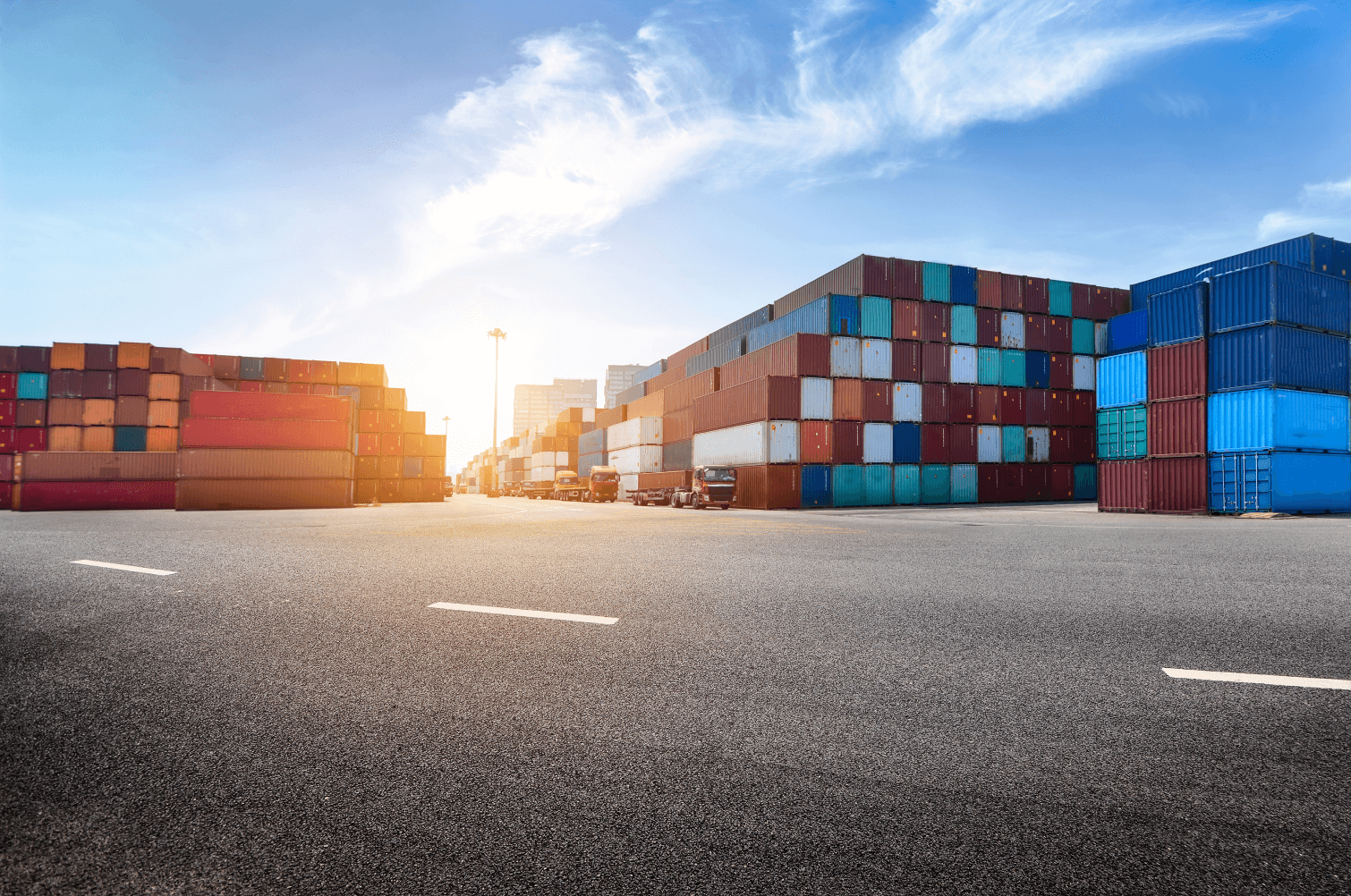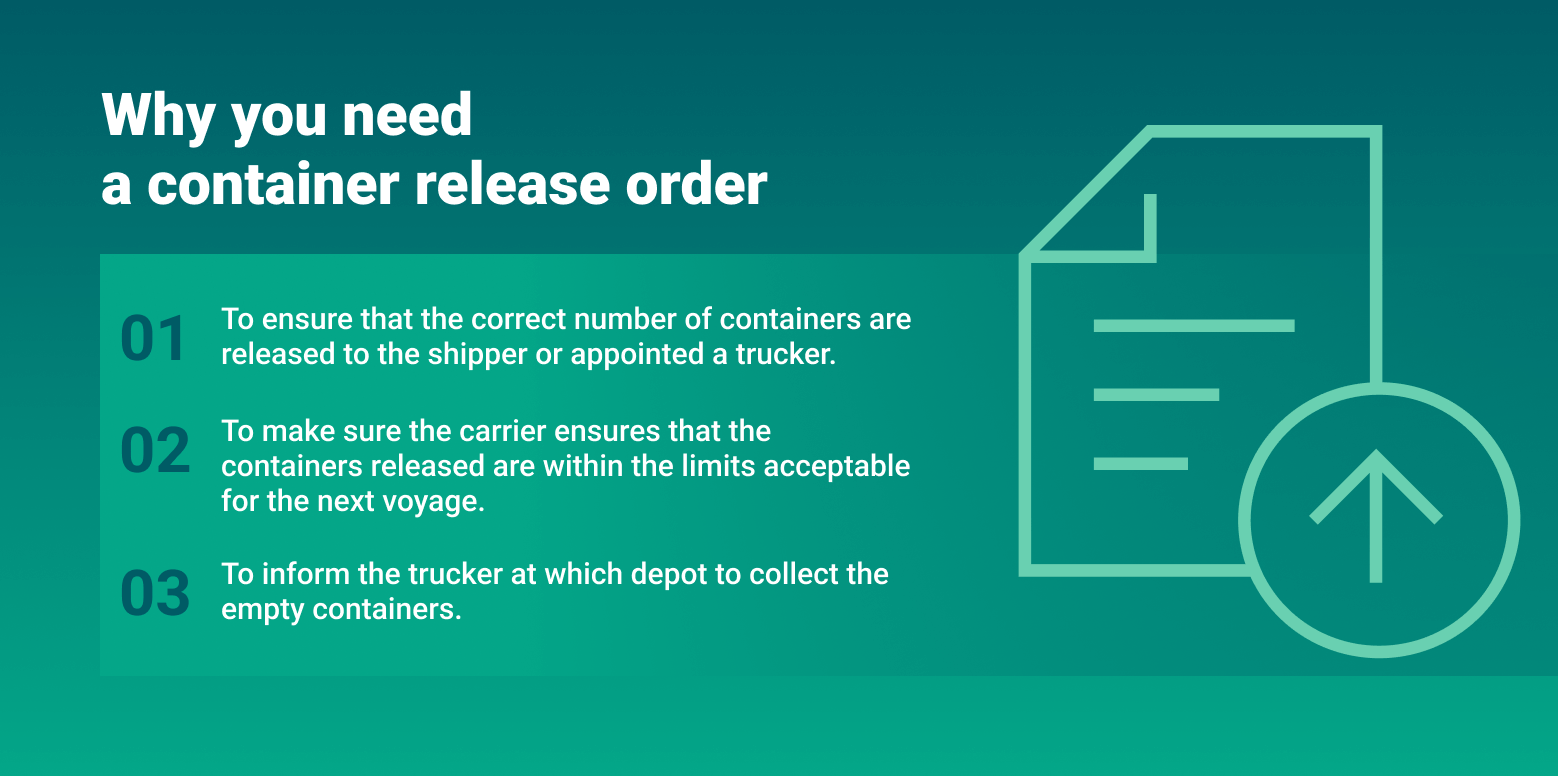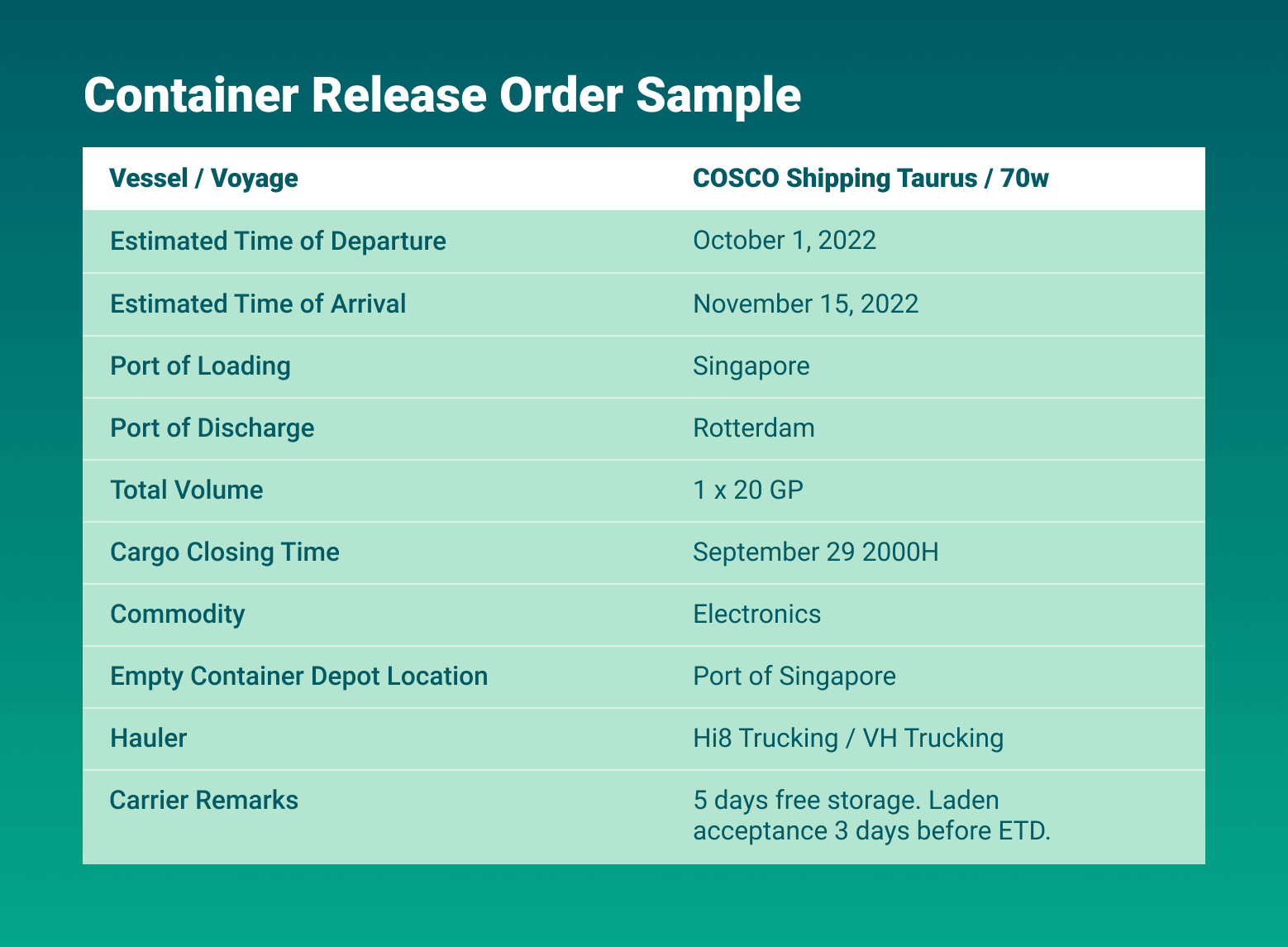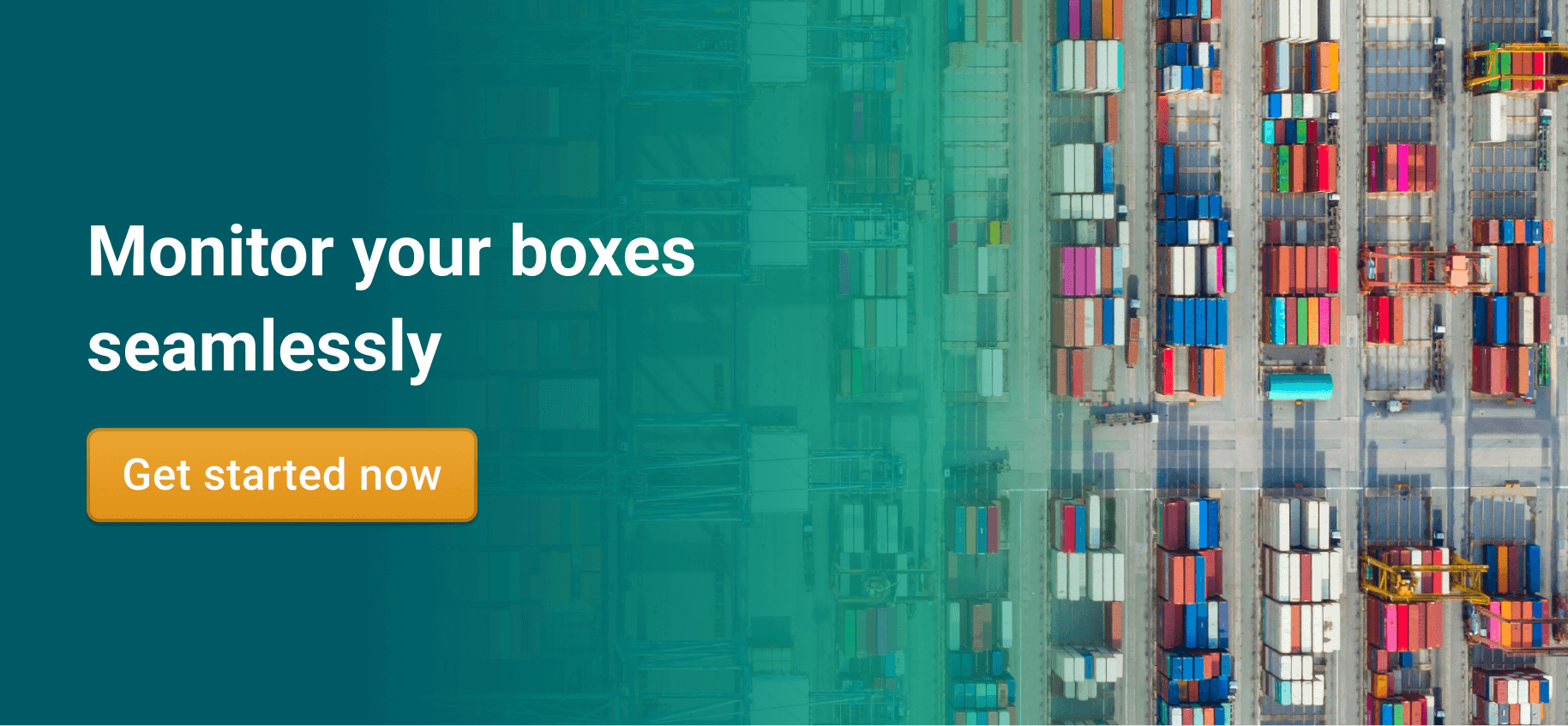What is a container release order, and why is it so important? This blog is here to help you understand this better. It’ll also help you find the best way to monitor your container movements from the depots.
Your empty containers ready to be stuffed with cargo are waiting at the depot. You’re looking forward to having them picked up soon by the truck driver and delivered to you. But you’re not receiving any update as to where your containers are. Have they even been picked up? You’ve no news so far to start planning your next steps. This can be quite unnerving.
What if we told you that we have a way to ease your worries by giving you near real-time updates about your container’s entire journey? You can get all the details about pick up and drop off after it leaves the depot. Not just that you’re also able to get updates about any delays to help manage your operations better.
Let’s move ahead to find out how you can avail these container monitoring advantages.
What is a container release order?
For your containers to be transported around the world without any hitches, different kinds of documents are needed. A container release order is one of those papers that you require.
An official document aka the container release order (CRO) is given by the shipping line to the shipper (the exporter), that’s you. This gives the authorization to you to pick up the empty containers at the designated depot using a nominated trucker.
Important container collecting details, including depot location, equipment amount, and type, are listed in the CRO document.
Why do you need the container release order?
It’s very crucial for you to know the details and information that the container release order states. This is because the CRO is for the following reasons:
- If you’re concerned about a miscalculation in terms of the number of containers. The CRO dictates the correct number of containers that are required to be released to you and your trucker.
- It also allows the shipping line to ensure that the containers released are within the suitable limits for the journey on the vessel.
- Another very important aspect it covers is informing the trucker at which depot to collect the empty containers.
When is the container release order issued?
To understand the function of a container release order and when it’s issued, we need to go back a few paces to explain prior stages in the shipping process.
Step 1: Before the container release order is released by the shipping line, you approach a shipping line (carrier) for transporting containers.
Step 2: The liner will then send you a vessel schedule. You will then choose an appropriate sailing date after reviewing the vessel’s schedule.
Step 3: The shipping line will then provide you with an empty booking copy for the booking details after you confirm the vessel itinerary.
Step 4: You must fill out the blank booking copy and return the completed copy back to the liner. Details concerning the cargo, including its weight, number of containers, consigneeWhat is a consignee? When transporting freight (by ocean, air, or land), there are two parties involved — one who is shipping and the other who is receiving the freight. The recipient of the goods b... More information, and instructions for container stuffing are all included in the booking copy.
Step 5: Based on the details of the booking copy the liner will give the required number of containers to you. Big shipping lines such as Hapag Lloyd, Maersk, and China Shipping have container services covering most ports of the world.
Step 6: Each container will have its unique number; the shipping line will give the details of the containers and will issue the container release order. With this order, you can collect the container from the depot for stuffing the cargo using a trucking service.
The CRO is also issued for the appointed trucker to know which depot to pick up your containers from and the exact number of containers needed to be collected.
What’s inside the container release order?
The container release order covers all of the vital information that you and your chosen trucker require to pick up the empty containers at the carrier’s depot.
And it’s crucial for you to check if all the details are good to go such as the number and type of containers, the port of origin and discharge, the type of commodity, the timings, and more details.
So, if you ever find yourself with the task of looking through a CRO, take a look at what you need to cross-check to ensure everything runs smoothly.
| Booking Number | The number generated by the shipping line to track the shipment from origin to destination. |
| Vessel / Voyage Number | The vessel of the liner where the containers will be transported on, as well as the voyage number. |
| Estimated Time of DepartureWhat is estimated time of departure? Estimated time of departure, or ETD, is the date/time when the vessel or container is expected to start off from the port of origin. ETD is significant as it giv... More | Date and time the vessel will leave the port of loading.
|
| Estimated Time of ArrivalWhat is estimated time of arrival? Estimated time of arrival, commonly known as ETA, is a frequently used term globally to denote the time of coming. In the shipping & logistics industry, it is ... More | Date and time that the vessel is going to arrive at the port of discharge.
|
| Origin port | Your containers are loaded onto the vessel at this port. |
| Destination port | And the port where the boxes are unloaded from the vessel after arrival is the destination port. |
| Equipment Type and Quantity | Type and number of containers that are going to be collected by the trucker.
|
| Commodity | Goods that you intend to load into the container. |
| Closing Time | Latest date and time a laden container can be accepted at the port of origin. |
| Trucker / Haulier | Company name of the trucker that is appointed by you to collect the empty containers.
|
| Carrier Remarks | If you have additional remarks they can be listed here. Example: free storage and charges if boxes stay in the port for a while waiting for vessel loading.
|
Explaining the empty container release order with a case study
To simplify this process for better understanding, here’s a case study you can look at. We will take two places and replicate the entire process, along with creating a mock-up of a CRO.
An exporter from Singapore called Singaporean Gadgets plans to export electronics from the Port of Singapore to the Port of Rotterdam. They require a single 20-foot container for this shipment.
The exporter connects with a shipping line and books a single 20-foot container.
After securing the box when the shipping line issues a booking confirmation, they also release a container release order, so that the exporter can have their empty containers picked up by their trucker.
Singaporean Gadgets shares the CRO with their appointed trucker, who arranges the pickup of the empty container from the depot and delivers it for loading at the exporter’s facility.
Shortly after, the containers are gated (the trucker delivers the laden container to the port terminal right after the container has been loaded by the exporter), they are then loaded onto the vessel for its journey to Rotterdam.
Take a look at our sample CRO below which matches our case study.
Simplify your container release order with Container xChange’s Container Control
You’ve now understood the importance of a CRO. But there are issues that can plague this process when it comes to monitoring your containers from the depot. So how can you manage this smoothly? Container xChange offers you a cutting-edge product called Container Control. With this product, you can get an outline of all the containers you’re moving and monitor them in near real-time from the pick-up location to the drop-off location.
A special feature of this product called the Release Reference can help you with your container release order. Let’s show you how it can help.
Just like at the beginning of the blog, you’re confused about what is happening with your containers because you have no updates from the shipping line. You’re left pondering if the designated trucker has picked them up, when, where, and how, it’s a complete question mark.
How the release reference can help
This is where the release reference feature can help. With this, you don’t have to rely on the shipping line for updates. You can quickly know which boxes have been picked up, where they were taken, and when. Data is obtained straight from depots in near real-time. Delays are thus a thing of the past due to the complete transparency and easy access to the data.
Additionally, you can cut down on depot costs as well as demurrage and detention fees by having complete visibility of the status of your containers. With this feature, you can also view information like ETAWhat is estimated time of arrival? Estimated time of arrival, commonly known as ETA, is a frequently used term globally to denote the time of coming. In the shipping & logistics industry, it is ... More, point of discharge, free days, and per diems.
What’s more? You won’t need to exchange emails back and forth to find out which containers are ready for pickup because we directly confirm release references with the depot. You’ll also receive near real-time monitoring of pickup and drop-offs and full support from us if you run into any issues with your container movement.
You may quickly link bookings to container release orders (references) and keep track of updates for each booking and container to streamline your container operations. To make things move more quickly, we also immediately upload your release references and validate the releases with the depot.
Booking Manager
We also have another feature called the Booking Manager under Container Control that can help you with your container release reference. How? Well, you can keep track of all your bookings and monitor your container’s journey in one place. By having everything under one platform you can assign containers from release references. This kind of complete transparency over bookings allows you to keep track of all your bookings and updates for every single container at any level of release.
Take note: You can have free access to Container Control by becoming a member of Container xChange and leasing containers on our platform at no extra charge.

Doesn’t this make your work easier? So go on then and grab a good deal on container leasing to get free access to the release reference and booking manager features to help revolutionize your container release order. Click the banner below to let our expert team answer all your questions as they show you around our marketplace.
Container release order vs delivery order
Now you know what a CRO is, but how does it differ from a delivery order exactly? Often these two forms of documentation can cause confusion. But there is definitely a difference between them,
- A container release order is responsible for collecting empty containers during the export process.
- On the flip side, a delivery order (DO) is used to collect laden containers from the port during the import process.
Find boxes, certified partners, and manage container release orders on xChange
So, there you have it, your container release order made easy with Container xChange. Become a member today to monitor your containers better. By easily connecting bookings to container release orders (references) and monitoring updates related to each booking and container. And get direct updates from depots in near real-time, to quickly learn which boxes have been picked up, from where, and when. Remember all your bookings are managed and available in one place without any added costs.
As soon as you enter our container leasing marketplace, you can browse through 10,000+ containers in 2,500 locations worldwide and lease the one that is most appropriate for your goods. Then you can check out the business profiles of our 1000+ vetted secured partners and the ratings and reviews that other clients have given them. To choose whom you want to work with.
After that, you can contact them directly through Container xChange to start negotiating for the best possible deals. Thanks to market transparency, you’ll get to see all the competitive rates and charges listed without any hidden fees.
If we take the case study example. By leasing a SOC for a one-way journey from Singapore to Rotterdam, you can stop worrying about repositioning costs afterward. Later on, after you’ve dropped off your cargo in Rotterdam you can sell the container again on our platform at a good price and help in repositioning them.
All this, plus an easy payment handling feature and container insurance and damage claims! What’re you waiting for? Get started on simplifying your container release order today! Click on the banner below to let out expert team help lead the way.
Container release order: Common FAQs
What does CRO mean in shipping?
An official document aka the Container Release Order (CRO) is given by the carrier to the shipper.
What is a cargo release order?
It is a document from a consigneeWhat is a consignee? When transporting freight (by ocean, air, or land), there are two parties involved — one who is shipping and the other who is receiving the freight. The recipient of the goods b... More. Or an owner or his agent of a freight carrier which orders the release of the transportation of cargo to another party.
Is a delivery order the same as a bill of lading?
A bill of lading is a document of title, a contract for the receipt of goods, and a negotiable instrument. The delivery order only facilitates the release of cargo by formally advising the carrier that all obligations have been settled and the appointed agent or consigneeWhat is a consignee? When transporting freight (by ocean, air, or land), there are two parties involved — one who is shipping and the other who is receiving the freight. The recipient of the goods b... More can now secure the cargo.
Who fills out the bill of lading?
A bill of lading is a legal document issued by a carrier to a shipper that details the type, quantity, and destination of the goods being carried.









